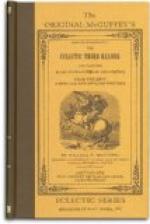6. A sportsman told me that he had, the day before—that was in the middle of October—seen a green chestnut burr dropped on our great river meadow, fifty rods from the nearest wood, and much farther from the nearest chestnut tree, and he could not tell how it came there. Occasionally, when chestnutting in midwinter, I find thirty or forty nuts in a pile, left in its gallery just under the leaves, by the common wood mouse.
7. But especially, in the winter, the extent to which this transportation and planting of nuts is carried on, is made apparent by the snow. In almost every wood you will see where the red or gray squirrels have pawed down through the snow in a hundred places, sometimes two feet deep, and almost always directly to a nut or a pine cone, as directly as if they had started from it and bored upward,—which you and I could not have done. It would be difficult for us to find one before the snow falls. Commonly, no doubt, they had deposited them there in the fall. You wonder if they remember the localities or discover them by the scent.
8. The red squirrel commonly has its winter abode in the earth under a thicket of evergreens, frequently under a small clump of evergreens in the midst of a deciduous wood. If there are any nut trees, which still retain their nuts, standing at a distance without the wood, their paths often lead directly to and from them. We, therefore, need not suppose an oak standing here and there in the wood in order to seed it, but if a few stand within twenty or thirty rods of it, it is sufficient.
9. I think that I may venture to say that every white-pine cone that falls to the earth naturally in this town, before opening and losing its seeds, and almost every pitch-pine one that falls at all, is cut off by a squirrel; and they begin to pluck them long before they are ripe, so that when the crop of white-pine cones is a small one, as it commonly is, they cut off thus almost everyone of these before it fairly ripens.
10. I think, moreover, that their design, if I may so speak, in cutting them off green, is partly to prevent their opening and losing their seeds, for these are the ones for which they dig through the snow, and the only white-pine cones which contain anything then. I have counted in one heap the cores of two hundred and thirty-nine pitch-pine cones which had been cut off and stripped by the red squirrel the previous winter.
11. The nuts thus left on the surface, or buried just beneath it, are placed in the most favorable circumstances for germinating. I have sometimes wondered how those which merely fell on the surface of the earth got planted; but, by the end of December, I find the chestnut of the same year partially mixed with the mold, as it were, under the decaying and moldy leaves, where there is all the moisture and manure they want, for the nuts fall fast. In a plentiful year a large proportion of the nuts are thus covered loosely an inch deep, and are, of course, somewhat concealed from squirrels.




